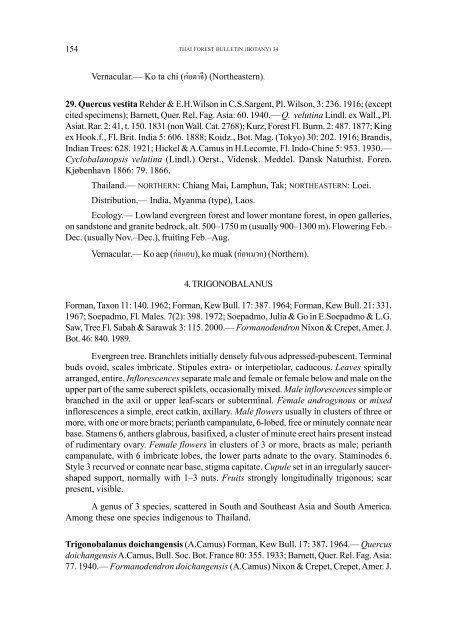A synoptic account of the Fagaceae of Thailand
A synoptic account of the Fagaceae of Thailand
A synoptic account of the Fagaceae of Thailand
Create successful ePaper yourself
Turn your PDF publications into a flip-book with our unique Google optimized e-Paper software.
154<br />
THAI FOREST BULLETIN (BOTANY) 34<br />
Vernacular.— Ko ta chi (°àÕµ“®’) (Nor<strong>the</strong>astern).<br />
29. Quercus vestita Rehder & E.H.Wilson in C.S.Sargent, Pl. Wilson, 3: 236. 1916; (except<br />
cited specimens); Barnett, Quer. Rel. Fag. Asia: 60. 1940.— Q. velutina Lindl. ex Wall., Pl.<br />
Asiat. Rar. 2: 41, t. 150. 1831 (non Wall. Cat. 2768); Kurz, Forest Fl. Burm. 2: 487. 1877; King<br />
ex Hook.f., Fl. Brit. India 5: 606. 1888; Koidz., Bot. Mag. (Tokyo) 30: 202. 1916; Brandis,<br />
Indian Trees: 628. 1921; Hickel & A.Camus in H.Lecomte, Fl. Indo-Chine 5: 953. 1930.—<br />
Cyclobalanopsis velutina (Lindl.) Oerst., Vidensk. Meddel. Dansk Naturhist. Foren.<br />
Kjøbenhavn 1866: 79. 1866.<br />
<strong>Thailand</strong>.— NORTHERN: Chiang Mai, Lamphun, Tak; NORTHEASTERN: Loei.<br />
Distribution.— India, Myanma (type), Laos.<br />
Ecology.— Lowland evergreen forest and lower montane forest, in open galleries,<br />
on sandstone and granite bedrock, alt. 500–1750 m (usually 900–1300 m). Flowering Feb.–<br />
Dec. (usually Nov.–Dec.), fruiting Feb.–Aug.<br />
Vernacular.— Ko aep (°àÕ·Õ∫), ko muak (°àÕÀ¡«°) (Nor<strong>the</strong>rn).<br />
4. TRIGONOBALANUS<br />
Forman, Taxon 11: 140. 1962; Forman, Kew Bull. 17: 387. 1964; Forman, Kew Bull. 21: 331.<br />
1967; Soepadmo, Fl. Males. 7(2): 398. 1972; Soepadmo, Julia & Go in E.Soepadmo & L.G.<br />
Saw, Tree Fl. Sabah & Sarawak 3: 115. 2000.— Formanodendron Nixon & Crepet, Amer. J.<br />
Bot. 46: 840. 1989.<br />
Evergreen tree. Branchlets initially densely fulvous adpressed-pubescent. Terminal<br />
buds ovoid, scales imbricate. Stipules extra- or interpetiolar, caducous. Leaves spirally<br />
arranged, entire. Inflorescences separate male and female or female below and male on <strong>the</strong><br />
upper part <strong>of</strong> <strong>the</strong> same suberect spiklets, occasionally mixed. Male inflorescences simple or<br />
branched in <strong>the</strong> axil or upper leaf-scars or subterminal. Female androgynous or mixed<br />
inflorescences a simple, erect catkin, axillary. Male flowers usually in clusters <strong>of</strong> three or<br />
more, with one or more bracts; perianth campanulate, 6-lobed, free or minutely connate near<br />
base. Stamens 6, an<strong>the</strong>rs glabrous, basifixed, a cluster <strong>of</strong> minute erect hairs present instead<br />
<strong>of</strong> rudimentary ovary. Female flowers in clusters <strong>of</strong> 3 or more, bracts as male; perianth<br />
campanulate, with 6 imbricate lobes, <strong>the</strong> lower parts adnate to <strong>the</strong> ovary. Staminodes 6.<br />
Style 3 recurved or connate near base, stigma capitate. Cupule set in an irregularly saucershaped<br />
support, normally with 1–3 nuts. Fruits strongly longitudinally trigonous; scar<br />
present, visible.<br />
A genus <strong>of</strong> 3 species, scattered in South and Sou<strong>the</strong>ast Asia and South America.<br />
Among <strong>the</strong>se one species indigenous to <strong>Thailand</strong>.<br />
Trigonobalanus doichangensis (A.Camus) Forman, Kew Bull. 17: 387. 1964.— Quercus<br />
doichangensis A.Camus, Bull. Soc. Bot. France 80: 355. 1933; Barnett, Quer. Rel. Fag. Asia:<br />
77. 1940.— Formanodendron doichangensis (A.Camus) Nixon & Crepet, Crepet, Amer. J.
















